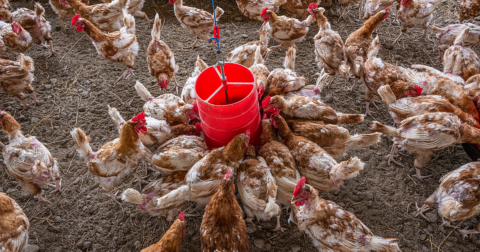Feature
The Sneaky Way Even Meat Lovers Can Lessen Their Climate Impact
Food•6 min read
Feature
A new investigation documents what happens to hens once they’re no longer laying eggs, even the cage-free ones.


Words by Grace Hussain
Lit only by infrared lights, employees of corporate poultry processor A.D. Harvey were caught on video throwing, kicking and rough handling end-of-lay hens — that is, birds who are no longer laying eggs. Now a new investigation spearheaded by Animal Justice Project is shedding light on how “catcher gangs” round up these birds for slaughter, including hens on cage-free egg farms.
Under the cover of night, each catcher gang captures thousands of birds. According to the investigator, a night of hen catching starts with corralling a large portion of the birds into one corner, primarily to make it easier for workers to grab multiple birds per hand. They often leave them swinging upside down by just one leg as they await their turn to load them in for transport.
The footage documents upwards of 20 hens being shoved into cages before the whole contraption is shaken in an apparent attempt to push the birds toward the bottom and make room for more.
Hens who lay so-called “cage-free” or “free-range” eggs aren’t spared from this treatment. The investigation features footage from several farms that produce eggs for these labels. Among them, the footage included images from Sunrise Poultry-owned Kettleby Farm, a major supplier to British grocery chains Co-op and Morrisons.
The processing company, A.D. Harvey, bills themselves as “specialists in the depopulation, transportation and processing of British end of lay hens, with an unwavering dedication to the highest quality standards in animal welfare, biosecurity and food safety.” Their “RSPCA Assured”-certified animal welfare status has been suspended in the wake of the new footage.
As more brands adopt the cage-free egg label, questions remain about how hens are treated across the board, and how much more humane cage-free eggs really are. The recently released footage illuminates end of life care — or lack thereof — for animals that produce foods like eggs and milk. Consumers may be surprised to learn that these animals are also slaughtered for meat.
It “all happened under the nose of the catching team managers as well,” says the investigator, whom we’ll refer to as P. “The cruelty is absolutely apparent…whether it’s intentional or whether it’s them turning a blind eye.” Even on farms operating under strict welfare certifications, P. recalls numerous instances of rule breaking.
Much like “humanely raised” and other animal welfare labels, certifications like RSPCA Assured are supposed to guarantee some level of treatment. In a statement responding to the investigation, the organization condemned the documented behavior saying it “goes against everything RSPCA Assured stands for and falls significantly below the high standards we demand of our members.”
Since reviewing the footage, the organization reported the incidents to the Animal and Plant Health Agency and suspended A.D. Harvey’s certification. A suspension does have significant implications — the catching company will not be able to work with any RSCPA Assured farms — but punishing one organization does not address whether the footage is indicative of a larger, industry-wide problem.
A.D. Harvey also released a statement, provided to Sentient Media by Animal Justice Project, that the staff featured in the footage “are no longer employed” by them and that the remaining staff is being retrained in proper animal handling.
The company failed to confirm whether Oliver Harvey, grandson of A.D. Harvey’s founder, who is featured overseeing and encouraging the workers in the footage, was among those relieved of their job.
Being part of a catcher gang is not an easy job, says the investigator. Most nights start with an hours-long van drive to the farm. Once there, teams of around eight to fifteen workers are tasked with catching thousands of birds, sometimes upwards of tens of thousands.
The teams typically spend most of the night rounding up birds in what are extremely dirty and dusty barns — “horrible rubbish” by the investigator’s own description.
The filth doesn’t do much for worker morale, according to P. Their “frustration is taken out on the animals,” he says. That frustration can and does turn deadly. Toward the end of each night, P. recalls, workers began picking up the injured birds and throwing them against walls, and trampled upon deceased birds.
Much of the staff were also intoxicated, P. says “Many people who ran the teams were alcoholics or drunk,” he says, which might explain how the animals were treated.
Some workers may have no other options, P. tells Sentient Media. During his short tenure with A.D. Harvey, P. heard rumors of people in other catcher gangs who were the victims of slavery — a not uncommon labor pool for the animal agriculture industry worldwide, both historically and today.
Despite the grueling nature of undercover work, “there’s no other way…to bring this to light,” P. tells Sentient Media. But P. says he’s at least carrying out the job “in a gentler and more respectful way,” providing the birds with a bit of relief in their final hours.